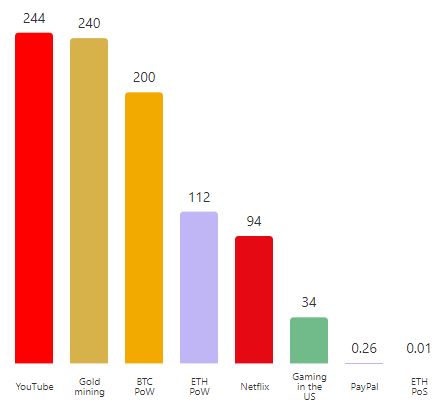How much energy do NFTs use? Less than you might think

Important takeaways
- NFTs have faced considerable criticism regarding their impact on the environment.
- Much of the criticism is rooted in a misunderstanding of how blockchains work.
- The large Layer 1 blockchains that serve as the main hubs for NFTs use less energy than critics seem to believe.
Share this article
Ethereum cut its energy consumption by 99.95% when it completed the merge, meaning NFTs are more environmentally friendly than ever. But did the ecological backlash against digital collectibles even make sense in the first place?
NFT Hype and Backlash
Is crypto art destroying the planet? Not as much as its deniers would have you believe, it turns out.
A new cultural phenomenon gripped the world in 2021. A generation of digital artists found a way to monetize their work on the blockchain through NFTs, causing the most coveted pieces to sell for eye-watering sums. Beeple made global headlines in March when he sold a $69 million NFT at Christie’s. Avatar-based NFT gatherings such as the Bored Ape Yacht Club also increased in popularity. Launched in April, Bored Apes was adopted by celebrities such as Paris Hilton, Jimmy Fallon and Snoop Dogg; a year later, their floor price topped out at around $435,000.
Most NFTs that appeared during the 2021 boom were minted on Ethereum as it used Proof-of-Work, a well-known energy-intensive consensus mechanism that also secures Bitcoin. This led to a backlash from certain mainstream media and crypto outsiders when they started doing it question the technology’s environmental impact. Critics denounced NFTs as carbon-intensive Ponzi schemes on social media, criticizing all artists and collectors who supported the technology.
While concerns over the environmental impact of any new technology are valid, much of the criticism leveled at NFTs is based on misconceptions about how blockchains work. So how much energy do NFTs really use? The hard data suggests it’s less than many critics seem to believe.
How blockchains work
The most common misconception surrounding NFTs and their environmental impact concerns the carbon footprint of making a blockchain transaction. Many people think that transactions cost a certain amount of energy, but they don’t.
Blockchains are cryptographic accounts or ledgers. These accounts keep an overview of all the transactions on the network in blocks. New blocks are created periodically to update the ledger with new transactions. Bitcoin creates a new block approximately every 10 minutes, while Ethereum does so every 10 to 20 seconds.
Blockchain networks are secured by service providers. Proof-of-Work blockchains like Bitcoin rely on miners, while Proof-of-Stake blockchains like Ethereum rely on validators. Miners and validators are responsible for adding new blocks to the chain at a constant rate. Miners need to run specialized hardware and validators also need equipment to contribute to their respective networks. While both use energy, mining is much more energy intensive.
The amount of energy block producers consume does not depend on the activity level of the network. Whether there are no transactions or thousands in a given period, blocks are produced at the same rate. In fact, blocks are often added to the chain with plenty of space left.
Adding an empty block to the chain requires the same amount of energy as a block filled with NFT coin. In crypto, the entire network uses energy – not individual transactions. Using the network to create an NFT has zero impact on blockchain’s ecological footprint.
Demystify gas prices
Are there any consequences for taking block space? Yes, but not when it comes to energy consumption. On Ethereum, for example, users pay for block space in gwei; one gwei is worth one billionth of 1 ETH. These are the “gas prices” cryptonatives refer to when they talk about transaction fees.
Buying, selling or sending NFTs uses the same amount of gas as transactions with other forms of cryptocurrency. While NFTs may take the form of digital art, music, or domain names, they live on the network as tokens. Sending an NFT does not take up more block space than sending any other type of token.
That said, minting an NFT requires significant block space. Some highly anticipated mints have led to large spikes in gas prices due to network congestion from NFT fans simultaneously vying for block space. Otherwise, the Metaverse world project from Bored Ape Yacht Club creator Yuga Labs cost miners more than $150 million in gas fees on their virtual land NFT drop in April.
However, while complex operations such as NFT minting may have higher transaction fees, they do not cause blockchains to consume more energy. The gas price is the only changing variable; energy use does not change even if the price does.
Ethereum’s energy usage
Ethereum is the world’s largest smart contract platform. It was the focal point of the NFT boom in 2021, with notable gatherings such as Bored Ape Yacht Club, CryptoPunks and Fidenza. The largest NFT marketplace, OpenSea, launched with support for Ethereum before expanding to other networks. Since Ethereum is actually the home of NFTs, it is important to consider energy consumption to understand how much NFTs impact the environment.
During its first seven years, Ethereum used a Proof-of-Work consensus mechanism like Bitcoin, which helped NFTs gain a bad reputation early on. In accordance Ethereum Foundationthe network’s power consumption peaked at 94 TWh per year when it was running Proof-of-Work, which is slightly more than the energy consumption of Bolivia.
While Ethereumenergy use rose from 2021 to early 2022, it dropped around 99.95% when the network completed the “merger”“ to Proof-of-Stake on September 15th. That’s because the network stopped relying on miners to produce blocks. According to the Ethereum Foundation, the network now consumes around 0.01 TWh per year.

After the transition to Proof-of-Stake, Ethereum now uses less energy than many services used by ordinary people, such as PayPal, Netflix and YouTube. As the Ethereum Foundation puts it, “estimates suggest that people consumed 45 times more energy watching Gangnam Style in 2019 than Proof-of-Stake Ethereum uses in a year.”
Furthermore, Ethereum promotes an active regenerative financial community that aims to build decentralized financial protocols that have a positive impact on ecological conditions. Ethereum has dropped its high energy consumption and is slowly becoming a social and environmentally friendly technology.
NFTs on other blockchains
While Ethereum is the main hub for NFTs, it is not the only network that hosts them. Other blockchains such as Solana, Tezos, Polygon and BNB Chain have all fostered relatively robust NFT communities. None of these networks use Proof-of-Work.
Solana’s energy use report from September 2022 states that the blockchain consumes approximately 4,056,273,936 Joules per hour. That corresponds to 9.87 KWh (or just under 0.01 TWh) per year, slightly less than Ethereum uses now.
Tezos is more energy efficient than Ethereum and Solana by using an estimated 0.001 TWh annually, according to Tezo’s estimates. The Proof-of-Stake network has branded itself as a “green” blockchain, inspiring many environmentally conscious crypto-artists to stamp their work on the network.
Polygon is an Ethereum scaling solution that hosts its own NFTs and is supported on OpenSea. 2021 estimates from Polygon team set the networkits energy consumption at around 0.00079 TWh annually, and the blockchain has recently committed to becoming carbon negative. In September 2022, Polygon stated that Ethereum’s transition to Proof-of-Stake would cut the scaling solution’s carbon footprint by 99.91%, bringing it to 56.22 tCO2e annually. That’s about the same emission level as 12 petrol-powered cars.
While BNB Chain has not shared data about its energy consumption, it uses Proof-of-Stake like Ethereum. But it is secured by only 21 validators, who need specialized hardware to process the chain’s enormous throughput. BNB Chain probably uses a similar amount of energy as its Layer 1 competitors, if not more.
Final thoughts
Energy consumption is a complex and nuanced topic. Even Proof-of-Work blockchains like Bitcoin can be environmentally friendly; it depends on the energy sources they use. Miners using solar, thermal, hydro or nuclear energy, for example, can be considered more environmentally friendly than those using fossil fuels. As Bitcoin advocate Nic Carter has tirelessly arguedis cryptomining a much greener industry than critics suggest.
It is also worth mentioning that criticism of energy use tends to be selective. YouTube uses more electricity than Bitcoin, but it doesn’t face as much pressure to go green. NFTs have received harsh treatment from major news outlets and skeptics, but the tide could change if more people start to learn about Proof-of-Stake or engage with the technology.
Regardless, NFT collectors need not worry about the environmental impact of their activity on the chain. Transactions do not increase energy consumption; that’s simply not how blockchains work. Most importantly, networks like Ethereum, Solana and Tezos have very low energy consumption. In other words, mint away.
Disclaimer: At the time of writing, the author of this piece owned BTC, ETH and several other cryptocurrencies.

























